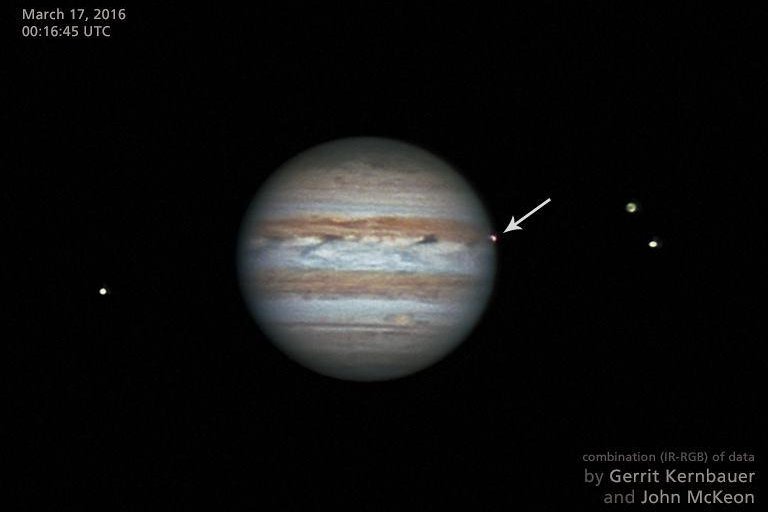An image shows a fireball impact recorded by amateur astronomer Gerrit Kernbauer and John McKeon on March 17, 2016. Photo by Sebastian Voltmer/G. Kernbauer/J. McKeon
NICE, France, May 18 (UPI) -- Every year, Jupiter's upper atmosphere is hit by an average of 6.5 meteors large enough to trigger fireballs that can be seen from Earth. The number is an estimate arrived at by a team of amateur astronomers from all over the world.
"Dramatic impacts with Jupiter can be captured with standard amateur equipment and analyzed with easy-to-use software," Marc Delcroix, a researcher with the French Astronomical Society who organized the group of amateur astronomers, said in a news release. "But to get a good estimate of how often these events occur, we need observers around the world who are willing to collaborate to create a program of more-or-less continuous monitoring of Jupiter."
Backyard sky-gazers from Australia, Europe, Japan, the United States and elsewhere have identified four Jupiter fireball impacts since June 2010. The last one was seen by amateur astronomers Gerrit Kernbauer and John McKeon in March of this year.
Since the project began three years ago, the team of amateur astronomers has also reviewed 53,000 videos without a single sign of a fireball.
"This is a result in itself and, together with the reports of amateur astronomer John McKeon, has helped us come up with our preliminary estimate which slightly reduces previous estimates of the flux of impacting objects in Jupiter," explained Delcroix.
Astronomers say software designed to model Jupiter fireballs don't have enough real data to produce accurate estimates. That's why monitoring by amateur astronomers is so valuable.
"We are still dealing with the statistics of a very few number of impacts detected, but plans to improve our detection methods and perform systematic searches will help us to detect more of these objects," said Ricardo Hueso, an astronomer with the University of the Basque Country. "That will allow us to know more about the current architecture of the outer Solar System and the role of Jupiter in protecting the Earth from comparable impacts."
Researchers are presenting the latest estimate at a workshop on Jupiter observations, organized by Europlanet 2020 Research Infrastructure and held this week at the Observatoire de la Côte d'Azur in Nice, France.
Europlanet 2020 Research Infrastructure is an collaborative research program sponsored by the European Union; its goal is to integrate and support planetary science activities throughout Europe.















